Chapter 1: Introduction
Table of Contents
![]() Previous
Previous
![]() Next
Next
Canada’s Economic Action Plan is working. Since the beginning of the recovery, the Canadian economy has continued to create jobs, with over 1 million more Canadians working today than during the worst part of the recession—the best job creation record of any Group of Seven (G-7) country over the period (Chart 1.1). Despite significant global weakness emanating in particular from the United States, our largest trading partner, the Canadian economy has continued to expand modestly, enjoying one of the best performances among G-7 countries over the recovery.
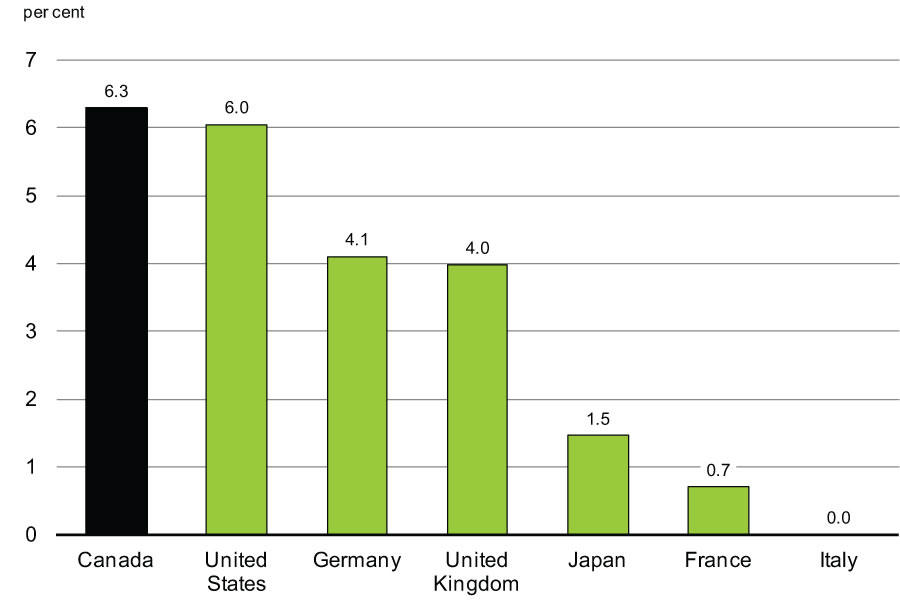
Sources: Haver Analytics; Department of Finance calculations.
However, Canada is not immune to external developments. Canada’s economy has been restrained by weak export markets and declines in commodity prices.
Indeed, the risks to global growth that have lingered throughout the recovery are still present. Financial market vulnerabilities in some emerging economies could translate into weaker-than-expected growth and increased financial market volatility more broadly. This could place additional stress on the euro area, where growth remains lacklustre. Furthermore, volatility in commodity prices remains a risk to the outlook.
Given the ongoing uncertainty in the global economic environment, it is important for the Government to continue to pursue the objectives of job creation and economic growth that have underpinned the Economic Action Plan since its inception in 2009, while remaining on track for balanced budgets.
To this end, the Government has announced and implemented a number of targeted, affordable measures that focus on:
- Equipping Canadians with the skills and training they need to succeed in the labour market, while also connecting them to available jobs.
- Supporting advanced research and innovation to foster a vibrant entrepreneurial culture where new ideas are translated into products and services in the marketplace.
- Reducing red tape and the regulatory burden faced by businesses.
- Helping to develop natural resources in a responsible and secure way.
- Helping businesses succeed in the global economy by encouraging trade and foreign investment to support our manufacturing sector and diversify our exports.
- Investing in public infrastructure, including by creating a new Building Canada plan—the largest long-term federal investment in infrastructure in Canadian history.
The Government has further supported the economy by keeping taxes low—in order to maintain the best economic environment possible for Canadians and Canadian businesses to prosper. The Government has pursued this goal by implementing both broad-based tax cuts and targeted tax relief for individuals, families and businesses since 2006.
The Economic Action Plan is working:
- Canada has experienced the strongest job growth among the G-7 countries over the recovery. Over 1 million more Canadians are working now than at the end of the recession, with the vast majority of new jobs being full-time, high-wage, private-sector positions.
- Real gross domestic product (GDP) in Canada is significantly above pre-recession levels—one of the best performances in the G-7.
- Canadians have experienced the strongest real per-capita income growth in the G-7 since 2006.
- Both the International Monetary Fund (IMF) and the Organisation for Economic Co-operation and Development expect Canada to be among the strongest-growing economies in the G-7 over this year and next.
- Canada’s business investment performance has been the strongest by far in the G-7 during the recession and recovery.
- For the sixth year in a row, the World Economic Forum rated Canada’s banking system as the world’s soundest.
- Canada is the only country in the G-7 to receive a triple-A rating with a stable outlook from all the major credit rating agencies.
- This year, Canada leapt from sixth to second place in Bloomberg’s ranking of the most attractive countries for business.
- Growth in foreign direct investment into Canada has been the strongest among the G-7 countries over the recovery.
- Government of Canada securities are among the world’s most sought-after investments. Indeed, the Canadian dollar is now one of the reserve currencies tracked by the IMF, alongside the U.S. dollar, the euro and the Swiss franc.
- Canada has the lowest net debt-to-GDP ratio, by far, of any G-7 country.
Actions taken by the Government since 2006 have helped the Canadian economy enjoy the strongest performance in the G-7, with almost 1.6 million new jobs created since the beginning of 2006. In addition, Canadians have enjoyed the strongest income growth in the G-7 by far (Chart 1.2). Indeed, Canadian families in all income groups have seen increases of about 10 per cent or more in their real after-tax, after-transfer income since 2006.
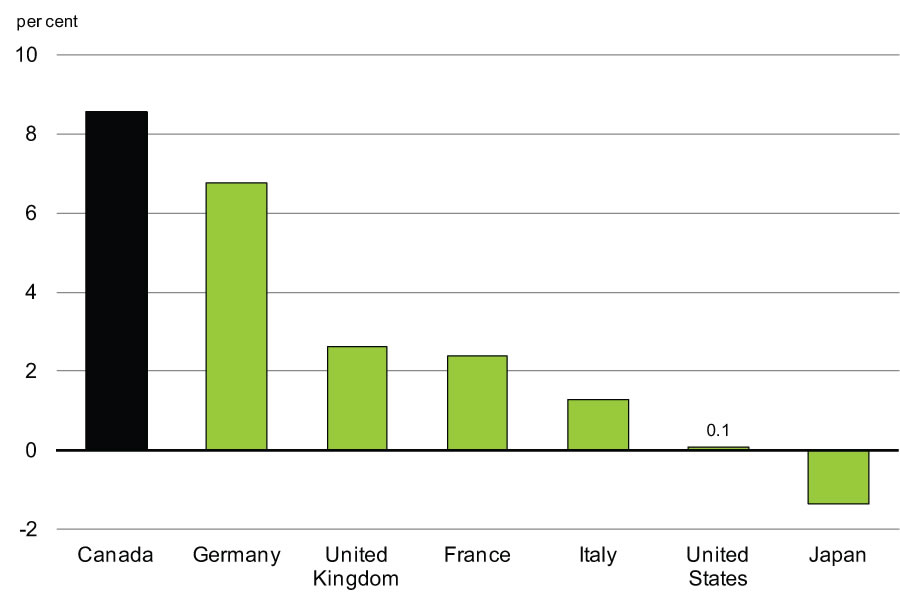
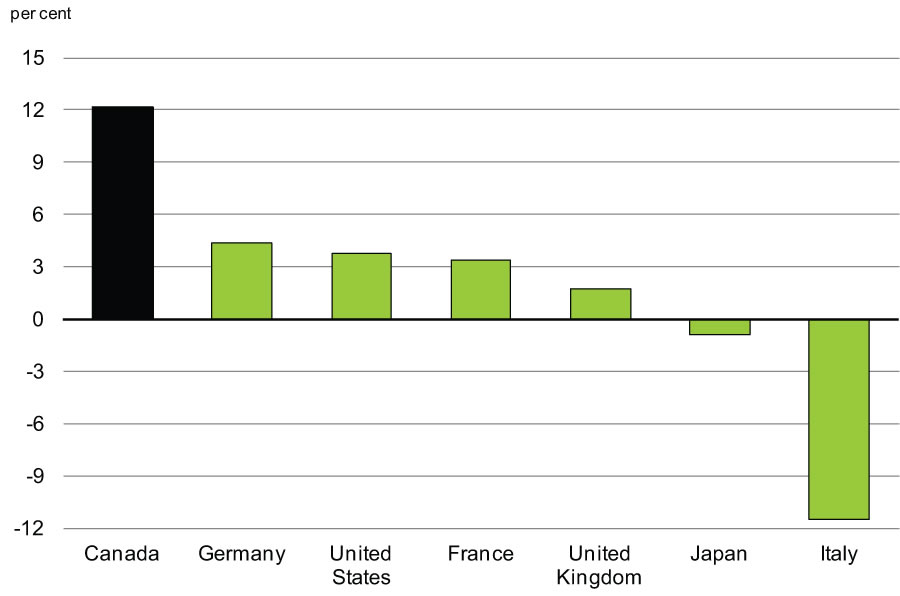
Economic Action Plan 2014 builds on these strengths. It continues to implement the Government’s plan for jobs and growth by:
- Connecting Canadians with available jobs by helping them to acquire the skills that will get them hired or help them get better jobs;
- Fostering job creation, innovation and trade by keeping taxes low; reducing the tax compliance burden; and continuing to provide Canadian businesses and investors with the market access they need to succeed in the global economy;
- Developing resources responsibly, conserving Canada’s natural heritage and investing in infrastructure and transportation by supporting the mining, forestry and agriculture sectors; investing in national parks and conservation initiatives; expanding tax support for clean energy; and making strategic investments in public infrastructure and transportation services; and
- Supporting families and communities by taking additional steps to protect Canadian consumers; keeping taxes low for families; and improving the safety of Canadians.
The Government’s efforts to support jobs and growth are underpinned by its plan to return to balanced budgets in 2015. This commitment to fiscal responsibility has helped to ensure that Canada maintains its hard-earned international economic and fiscal advantage, which will help foster a growing, healthy economy that creates stable, well-paying jobs for Canadians.
Indeed, the Government’s plan to return to balanced budgets is not an end in itself, but a means to increase Canada’s economic potential, improve employment opportunities for Canadians and raise our standard of living. It is for this reason that the Government has made returning to balanced budgets the cornerstone of its Economic Action Plan.
Connecting Canadians With Available Jobs (Chapter 3.1)
Economic Action Plan 2013 reformed the skills training system to better help Canadians acquire the skills that will get them hired or help them get better jobs.
With Economic Action Plan 2014, the Government is taking further steps to ensure federal funding and programs are directed towards meeting labour market needs. The Government is also working to make it easier for Canadians to connect with available jobs, and to ensure that Canadians are given the first chance at those jobs. Specifically, Economic Action Plan 2014:
- Better aligns training with labour market needs through the Canada Job Grant.
- Introduces a new generation of Labour Market Agreements for Persons with Disabilities. Over the next four years the Government will provide $222 million annually through these transfers, to be matched by provinces and territories, to better meet the needs of persons with disabilities and employers.
- Connects persons with developmental disabilities with jobs through the Ready, Willing & Able initiative and supports the creation of vocational training centres for persons with Autism Spectrum Disorders.
- Creates the Canada Apprentice Loan by expanding the Canada Student Loans Program to help registered apprentices in Red Seal trades with the costs of training and introduces the Flexibility and Innovation in Apprenticeship Technical Training pilot project to expand the use of innovative approaches for apprentice technical training.
- Focuses federal investments in youth employment to provide real-life work experience in high-demand fields.
- Provides an additional $40 million to the Canada Accelerator and Incubator Program to help entrepreneurs create new companies and realize the potential of their ideas through intensive mentoring and other resources to develop their business.
- Invests to reform the on-reserve education system, in partnership with First Nations, through the First Nations Control of First Nations Education Act.
- Renews and expands the Targeted Initiative for Older Workers for a three-year period, representing a federal investment of $75 million to assist unemployed older workers.
- Provides $11.8 million over two years and $3.3 million per year ongoing to launch an enhanced Job Matching Service to ensure that Canadians are given the first chance at available jobs that match their skills in their local area.
- Invests $11.0 million over two years and $3.5 million per year ongoing to strengthen the Labour Market Opinion process to ensure Canadians are given the first chance at available jobs.
- Provides $14.0 million over two years and $4.7 million per year ongoing towards the successful implementation of an Expression of Interest economic immigration system to support Canada’s labour market needs.
Fostering Job Creation, Innovation and Trade (Chapter 3.2)
In order to promote job creation and improve the conditions for business investment, the Government has taken a range of actions to increase Canada’s openness to trade and investment, provide tax relief, improve the regulatory environment, promote business competiveness and strengthen the financial sector. Economic Action Plan 2014 builds on this foundation by:
- Not introducing new taxes on business.
- Building on the work of the Red Tape Reduction Commission by reducing the tax compliance and regulatory burden for small and
medium-sized businesses. - Further reducing barriers to the international and domestic flow of goods and services.
- Moving forward with the planning for and construction of a new Windsor-Detroit International Crossing to improve the flow of people and goods between Canada and the United States.
- Creating the new Canada First Research Excellence Fund with $1.5 billion in funding over the next decade to help Canada’s post-secondary institutions excel globally in research areas that create long-term economic advantages for Canada.
- Providing an additional $500 million over two years to the Automotive Innovation Fund to support significant new strategic research and development projects and long-term investments in the Canadian automotive sector.
- Modernizing regulation and legislation to better protect investors and taxpayers, enhance Canada’s financial services sector and support efficient capital markets.
Responsible Resource Development, Conserving Canada’s Natural Heritage, and Investing in Infrastructure and Transportation (Chapter 3.3)
Major natural resource projects are an important source of development and job creation in all regions of Canada. Our diverse and abundant natural resource sector is an asset that benefits all Canadians. Economic Action Plan 2014 proposes to take further steps to ensure safe and responsible resource development, and conserve Canada’s natural heritage, by:
- Committing to respond to the recommendations made by the Tanker Safety Expert Panel and the Special Representative on West Coast Energy Infrastructure.
- Providing $28 million over two years to the National Energy Board for comprehensive and timely reviews of project applications and to support the Participant Funding Program.
- Continuing to support the forestry, mineral exploration and agriculture sectors.
- Asserting Canada’s sovereignty in the North.
- Investing new resources to protect Canada’s rich natural heritage.
Economic Action Plan 2014 also proposes to make strategic investments in public infrastructure and transportation services across Canada, including in major bridges, small craft harbours and ports, and ferry services.
Supporting Families and Communities (Chapter 3.4)
Economic Action Plan 2014 builds on previous actions by the Government to support families and communities. Specifically, Economic Action Plan 2014:
- Supports Canadians by advancing the Government’s Consumers First Agenda and better protecting financial consumers.
- Invests $305 million over five years to extend and enhance broadband internet service for Canadians in rural and Northern communities.
- Keeps taxes low, helps make adoption more affordable for Canadian families and provides further tax recognition of health-related expenses.
- Helps communities and workplaces by taking additional steps to support the charitable sector, improve the health of Canadians, support our arts and cultural communities, and honour our veterans.
- Takes action for Canadians in need, for example by helping Canadians prepare for and recover from natural disasters and by introducing a Search and Rescue Volunteers Tax Credit in recognition of the important role played by these volunteers.
- Proposes measures to improve the health and safety of Aboriginal communities, including investments in water infrastructure and efforts to reduce violence against Aboriginal women and girls.
Supporting a Return to Balanced Budgets in 2015 (Chapter 4)
The Government’s plan to return to balanced budgets in 2015 has been driven by strong financial management and restraining the growth of departmental spending. Since Budget 2010, the Government has implemented a number of targeted actions and broad-based reviews to reduce the operating and administrative expenses of federal departments, without compromising the delivery of priority services to Canadians.
These measures have been augmented by the adoption of initiatives designed to improve the integrity, fairness and neutrality of the tax system and to ensure that everyone plays by the same rules, which in turn helps to keep taxes low for hard-working Canadians.
Economic Action Plan 2014 builds on these initiatives by announcing that the Government:
- Intends to transition from currently paying 75 per cent of benefit costs to equal cost sharing for retired federal employees who choose to participate in the Public Service Health Care Plan, as well as to increase the minimum years of service required to be eligible for the plan.
- Will enter the 2014 round of negotiations with collective bargaining agents with the policy priority to implement a disability and sick leave management system that is modern, comprehensive, and responsive to the needs of all employees.
Taking into account the above savings measures, and the adjustment of National Defence funding for major capital procurements into future years in which key purchases will be made, direct program spending in Economic Action Plan 2014 is projected to remain broadly in line with its 2010–11 level over the forecast horizon. In contrast, federal transfers to individuals that provide important income support, such as Old Age Security, and major transfers to other levels of government for social programs and health care will continue to grow over the forecast horizon.
Economic Action Plan 2014 also proposes a number of measures that reflect the Government’s ongoing commitment to improving the fairness and integrity of the tax system and ensuring that everyone pays their fair share.
The Government is on track to return to balanced budgets in 2015. The deficit has been reduced by almost two-thirds since the height of the global economic and financial crisis, from $55.6 billion in 2009–10 to $18.9 billion in 2012–13. Looking forward, including the measures announced in Economic Action Plan 2014, the Government expects to realize a surplus of $6.4 billion in 2015–16, after taking into account the $3.0-billion annual adjustment for risk (Chart 1.3).
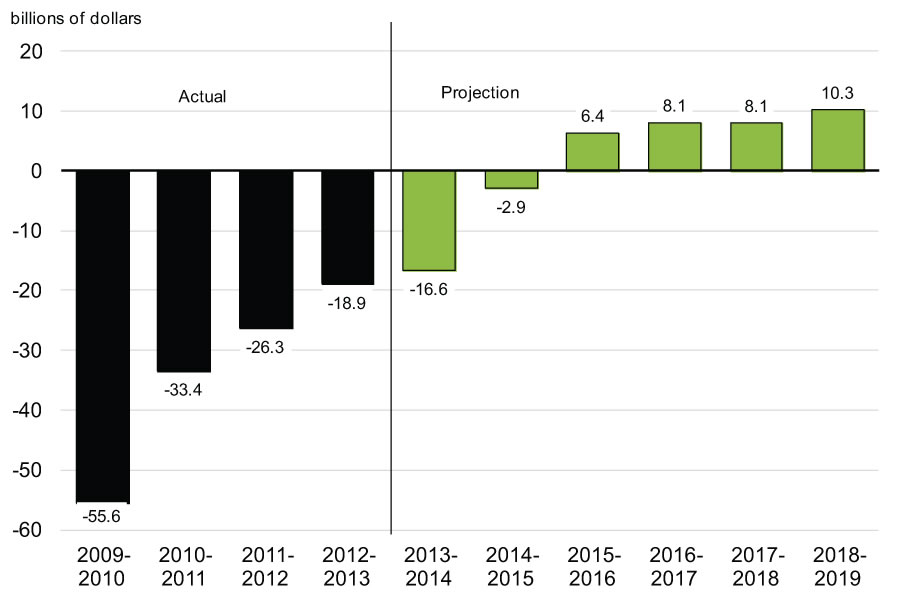
Returning to a balanced budget in 2015 will help ensure that the federal debt-to-GDP ratio remains on a downward path (Chart 1.4). Lower debt levels mean lower debt-servicing costs, which will result in lower taxes for Canadians and a strong, stable investment climate that supports job creation and economic growth.
At the G-20 Leaders’ Summit in St. Petersburg, Russia, last September, Prime Minister Stephen Harper announced Canada’s commitment to achieve a federal debt-to-GDP ratio of 25 per cent by 2021.
The return to balanced budgets in 2015 will significantly contribute to reducing Canada’s federal debt-to-GDP ratio to below its low, pre-recession level by 2017–18, putting the Government well on its way towards achieving its target of 25 per cent of GDP by 2021.
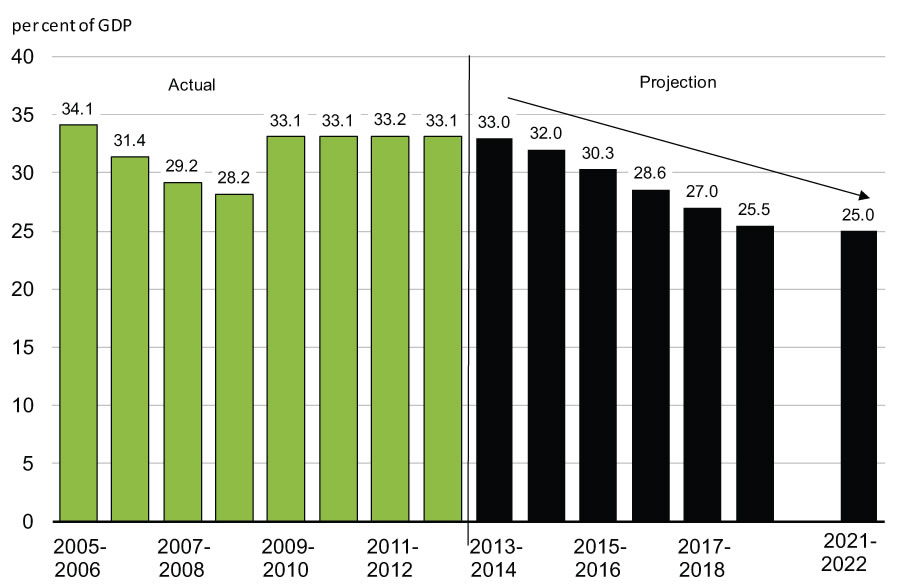
Conclusion
Implementing policies focused on raising Canada’s economic potential and creating stable, well-paying jobs continues to be the Government’s top priority. Economic Action Plan 2014 takes additional steps to achieve these objectives, especially returning to budget balance in 2015. Maintaining focus on these priorities is the best way to ensure that Canada is prepared to weather any future economic storm that may arrive from outside our borders. It is also the best way to ensure that Canada’s future is a prosperous one, with a healthy, competitive economy fuelled by low taxes, and government services that are sustainable for generations to come.

